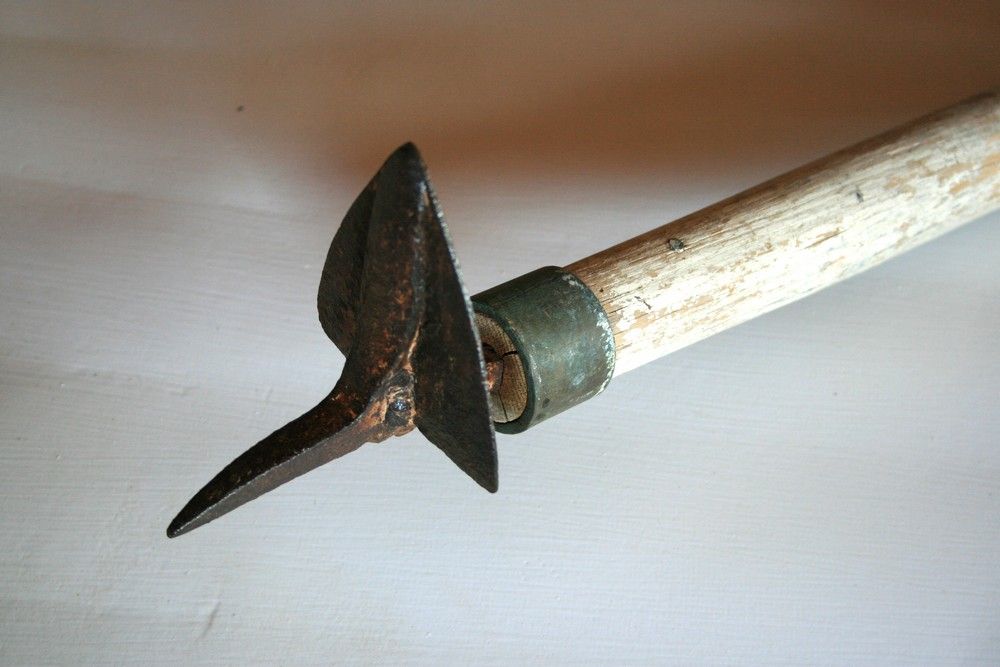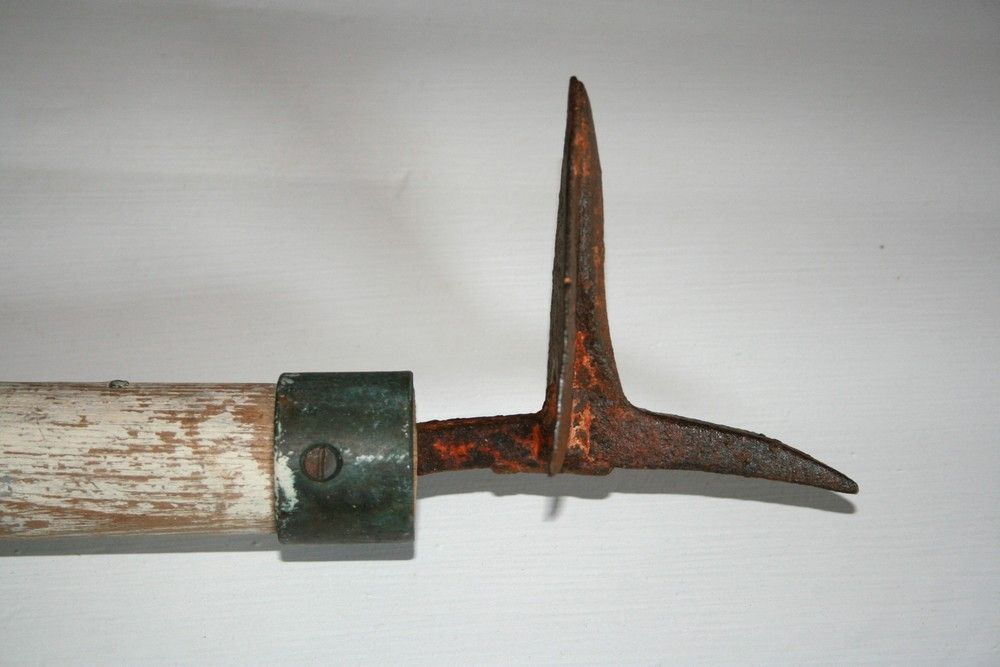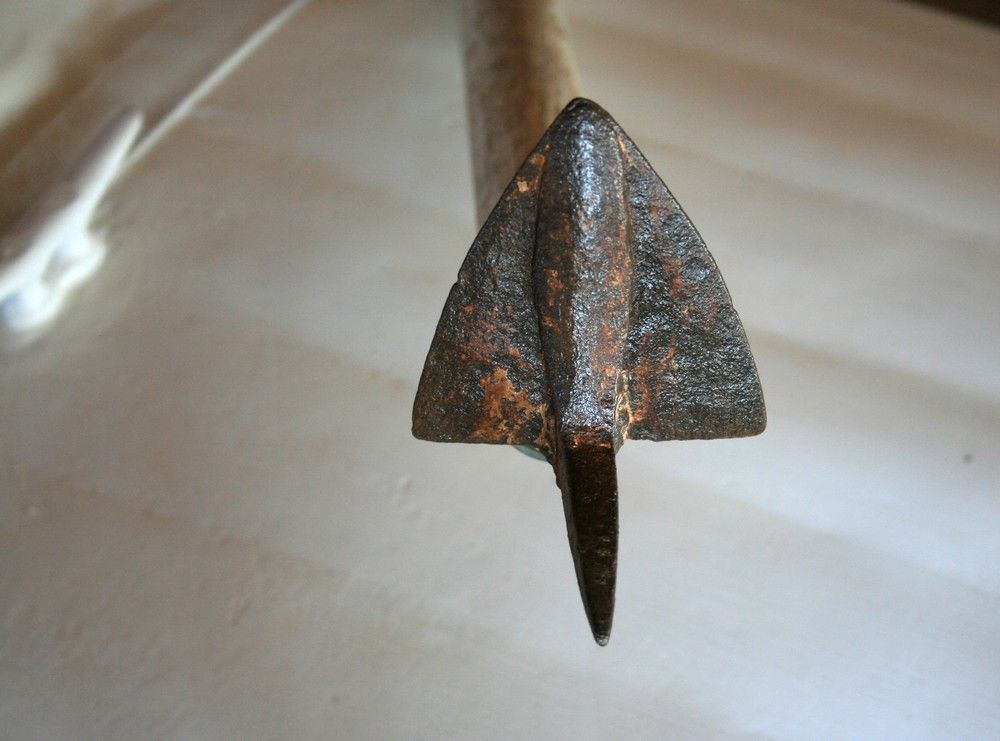Steve Sanford
Well-known member
I just got back from Long Island - and brought with me the final "missing piece" for my Great South Bay Scooter - a beautiful Scooter Hook/Pike Pole thanks to the grandson of the man who built the original Scooter back in the 1880s. Although Schuyler "Bud" Corwin was unavailable over the weekend, he passed along to me a really nice Scooter Hook (the fitting) mounted on an elegantly shaped 7-foot ash handle - altogether known locally as a Pike Pole. The Pike Pole is used both to push the Scooter along on top of the ice - and also to pull the Scooter out of water (an "air hole") or through "porridge ice" (too soft to support the boat, too thick to row).
The unique feature of a Scooter Hook is the combination of the pointed Spur (aka Spike) and the spade-like Flange (aka Hoe). This enables both the pushing and the pulling - so necessary to ice work.
A few of you have asked for details and measurements on the Scooter Hook - so here you go....

Here is the Profile:

Here is the Plan View:

Here is a head-on view of the Flange (aka Hoe):

Here is a measured drawing - if you print the image on 8.5 x 11 paper, it is a full-size (1:1) drawing.

Although I try to make my own boats and gear whenever I can, I have NO expertise with metal-working. Making a Scooter Hook requires the skills of a blacksmith - someone who knows how to shape, weld and temper steel so it does its job.
NOTE: This Pike Pole has a fairly short (1-1/4" long) ferrule - cut from a length of either brass or copper pipe. Most of the Pike Poles I have seen have a longer ferrule - typically 3 or even 4 inches long.
Also, note that there is a steel pin that goes through the shank of the Scooter Hook; this is peened over on both sides of the handle. I presume that the handle is bored lengthwise to receive the shank - which is made from square stock.
Here is the Pike Pole ready for use (although I will put a couple of coats of paint on it). This one is about 7' long - but some are much longer, perhaps 12' in length. I like one that can easily stow inside the boat while gunning or rowing.

Most of the handles I have seen are simple, straight-sided poles - about 1 5/8" in diameter; they may be reduced in diameter to fit the ferrule. This one is elegantly tapered at both ends. Near the ferrule, the taper begins about 4-1/2 inches back from the beginning (aft end) of the ferrule. The other end is rounded over like most rake handles. The diameter is full for the first 5 inches then tapers down to 1-1/4" inches by the time it reaches the 6-inch mark. This 1-1/4" section very gradually tapers back to full diameter at the 36-inch mark. These subtle changes in shape are not merely aesthetic. They tell me where my hands are on the pole without having to look.
All the best,
SJS
The unique feature of a Scooter Hook is the combination of the pointed Spur (aka Spike) and the spade-like Flange (aka Hoe). This enables both the pushing and the pulling - so necessary to ice work.
A few of you have asked for details and measurements on the Scooter Hook - so here you go....

Here is the Profile:

Here is the Plan View:

Here is a head-on view of the Flange (aka Hoe):

Here is a measured drawing - if you print the image on 8.5 x 11 paper, it is a full-size (1:1) drawing.

Although I try to make my own boats and gear whenever I can, I have NO expertise with metal-working. Making a Scooter Hook requires the skills of a blacksmith - someone who knows how to shape, weld and temper steel so it does its job.
NOTE: This Pike Pole has a fairly short (1-1/4" long) ferrule - cut from a length of either brass or copper pipe. Most of the Pike Poles I have seen have a longer ferrule - typically 3 or even 4 inches long.
Also, note that there is a steel pin that goes through the shank of the Scooter Hook; this is peened over on both sides of the handle. I presume that the handle is bored lengthwise to receive the shank - which is made from square stock.
Here is the Pike Pole ready for use (although I will put a couple of coats of paint on it). This one is about 7' long - but some are much longer, perhaps 12' in length. I like one that can easily stow inside the boat while gunning or rowing.

Most of the handles I have seen are simple, straight-sided poles - about 1 5/8" in diameter; they may be reduced in diameter to fit the ferrule. This one is elegantly tapered at both ends. Near the ferrule, the taper begins about 4-1/2 inches back from the beginning (aft end) of the ferrule. The other end is rounded over like most rake handles. The diameter is full for the first 5 inches then tapers down to 1-1/4" inches by the time it reaches the 6-inch mark. This 1-1/4" section very gradually tapers back to full diameter at the 36-inch mark. These subtle changes in shape are not merely aesthetic. They tell me where my hands are on the pole without having to look.
All the best,
SJS
